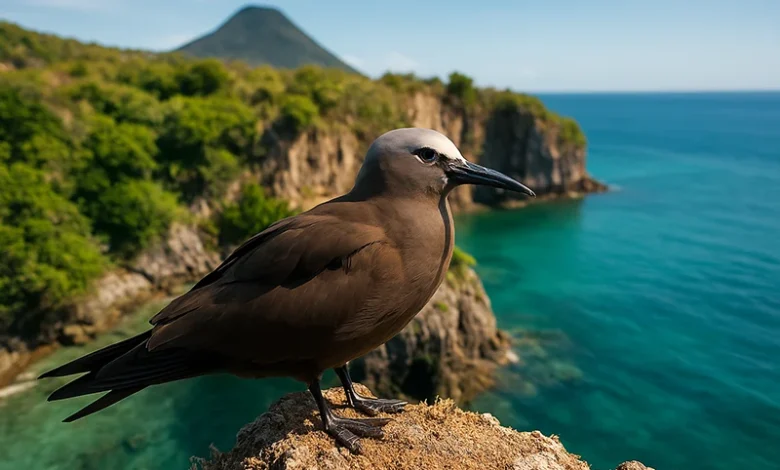Brown Noddy

The Brown Noddy (Anous stolidus) is a sleek, ocean-loving seabird found along Dominica’s cliffs, offshore islets, and coastal skies. As one of the most widespread tropical terns, it is a common nesting species in the region, and in Dominica, it is especially associated with seabird colonies on rocky outcrops and islets just off the island’s southern and east coast. Graceful in flight and dedicated in parenting, the Brown Noddy is a sentinel of Dominica’s marine biodiversity.
Appearance and Identification
Measuring about 38–45 cm (15–18 inches) long with a wingspan of 75–86 cm (30–34 inches), the Brown Noddy is sooty brown overall with a pale gray to white cap, dark facial mask, and strong black bill. Its long, slender wings and forked tail allow agile and effortless gliding over the ocean. Unlike gulls, it rarely flaps rapidly—instead, it moves with calm, level flight patterns. It often appears darker than other terns and is usually seen flying low over the water.
Habitat and Nesting in Dominica
The Brown Noddy is a colonial nester, often breeding on coastal cliffs, small rocky islets, and ledges that are safe from predators. Key locations associated with the species include:
- Scotts Head Peninsula and Soufrière Bay – Birds often seen flying offshore or roosting near rock faces.
- La Sorcière and offshore rocks near Grand Bay – Potential nesting sites with limited disturbance.
- Cabrits National Park coastline and adjacent islets – Important seabird habitat used by multiple species including noddies.
- The cliffs near Rosalie and Castle Bruce – Occasional foraging and resting zones.
Their nests are made of twigs and seaweed and placed directly on rock ledges or crevices, with a single egg laid per breeding cycle.
Behavior and Birdwatching Tips
The Brown Noddy feeds by surface-dipping—skimming the ocean for small fish, squid, and marine invertebrates. It rarely plunges deep and instead snatches prey in flight. Birds are often seen in flocks, especially near fishing boats or areas with schools of fish.
Tips for observing Brown Noddies:
- Look for slow-flying, dark seabirds over open water, especially from coastal lookouts.
- Visit southern or eastern headlands during the breeding season (April to August) for best chances.
- Scan cliffs and offshore rocks with binoculars for roosting or nesting birds.
- Early morning and late afternoon provide the best lighting and activity.
Local Role and Conservation
Though not endangered, the Brown Noddy is vulnerable to habitat loss, introduced predators, and marine pollution. It serves as an indicator of healthy marine ecosystems, and its nesting success helps scientists monitor the condition of Dominica’s seabird colonies. Conservation of nesting sites—particularly offshore rocks and cliffs—is essential for its long-term presence.
The Brown Noddy is one of Dominica’s most elegant seabirds, soaring across the waves with quiet confidence. It represents the strength and subtle beauty of the island’s oceanic life.




